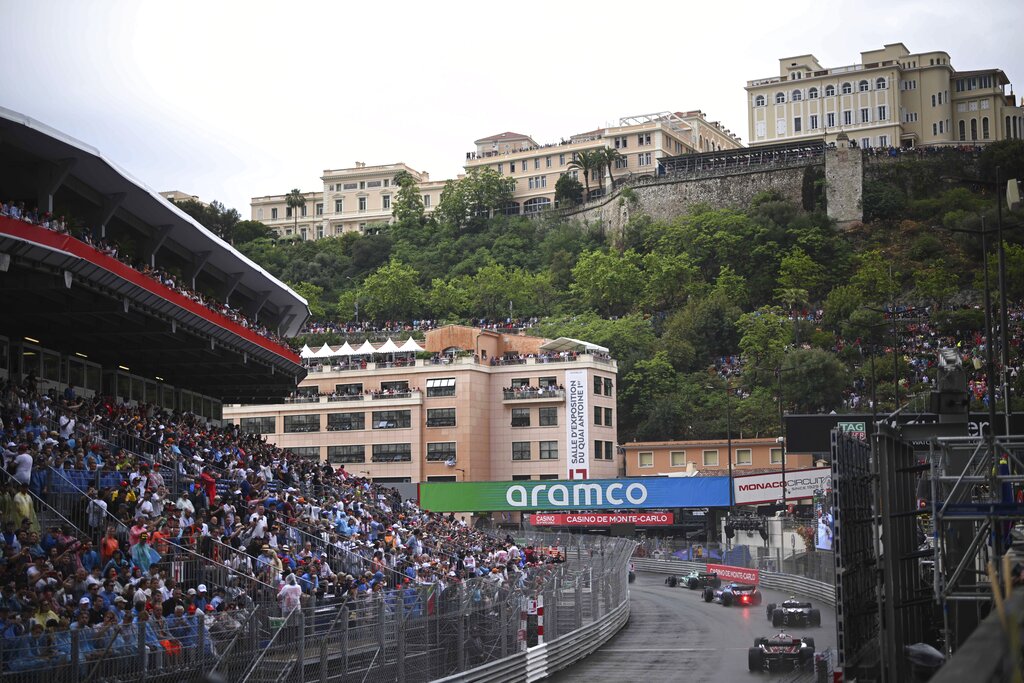Table of Contents

The Monaco F1 Track and Race
F1 Event: Monaco Grand Prix
Circuit name: Circuit de Monaco
Location: Monte Carlo, Monaco
Circuit length: 3.337 Km
Race length: 220.286 km
Laps: 78
Previous winner – Drivers Championship (2022): Sergio Perez, Red Bull
Previous winner – Constructors Championship (2022): Red Bull
Fastest lap (2022):
Fastest lap (all time): 1:12:909 Lewis Hamilton Mercedes (2021)

While iconic, the Monaco F1 track is far from the typical F1 circuit. It’s very tight, windy, and slow by comparison to most other stops on the F1 calendar. Famed driver Nelson Piquet once described driving an F1 car around Monaco as similar to “riding a bicycle around your living room.” In addition to close-quarters racing with scant room for overtakes, the Circuit de Monaco features a number of surface changes, making tire management here challenging.
These challenges are offset by the sheer pageantry of Monaco and the unique racing experience the circuit provides. While there is only one Drag Reduction System (DRS) Zone here, where drivers reach top speeds, there are fairly long, bending runs through both the city and along Monte Carlo’s spectacular harbourfront.
What’s It Like to Drive the Monaco F1 Race Track?
Here’s what the Monaco F1 GP circuit looks like from a simulated cockpit with the world’s current #1 driver, the Netherlands Max Verstappen, behind the wheel on race day.
The Monaco F1 track begins with a short sprint, leaning slightly right before a complex 90-degree Turn 1 that forces drivers to make a choice on the more efficient outer racing line, or a daring dive down the inside. Lap 1, Turn 1 is often crucial to the outcome of the Monaco Grand Prix. From there, you’re on the gas into a very fast, left-leaning Turn 3, before a quick whip back right under braking in Turn 4. This takes us into the right-handed Turn 5, and the entrance to the slow and difficult Section 2 of the Monaco race track, where the track is narrow and passing is difficult.
In Section 2, drivers are clustered together by the circuit’s ever-present walls and the Turn 6 hairpin, which is by far the slowest point on the track. From there, it’s important to get a clean racing line to Turn 7 in order to build speed for the difficult Turn 8, where a good exit is key to setting up pace for the long, leaning section ahead; controlled acceleration and nailing your braking point heading into the short, low-speed chicane of Turns 10 and 11 are key here, otherwise, you will take a penalty. From there, you want to get on the gas as soon as possible to build speed for the high-speed Turn 11 and the entrance to Section 3 and track one DRS Zone.
Section 3 begins with a quick jog to the left under acceleration, followed by hard braking to make a short 90-degree right at Turn 15, and again back to the left at Turn 16. From there, you enter Monaco’s one and only DRS Detection Zone. If you are within one second of the car in front of you, this will gain you an advantage as you build speed into the final Turn for the home straight. Here, drivers who are within that one-second margin can deploy their Drag Reduction System (basically, the rear wing opens), thereby increasing their top speed and opportunity for an overtake. As you cross the chequered flag, the track re-starts with a hot run into Turn 1.
By driving around the Circuit de Monaco, you can follow the tire marks of former Formula 1 World champions such as Aryton Senna, Michael Schumacher, and Alain Prost. You will also pass many iconic sites on your way, including the Monaco Opera House, the Monte Carlo Casino, and the length of the city’s world-renowned harbor front where the world’s largest super yachts anchor. As stunning as it is complex, Monaco is truly a unique and challenging F1 track to drive under any conditions.
Monaco F1 Track FAQs
- When was the Monaco F1 track built?
Monaco has been around since 1215, while the first record of auto racing in city streets dates back to about 1929 and was organized by the Automobile Club de Monaco. The first F1 race here was in 1950, the inaugural season of the Formula 1 Championship. The Monaco GP has been a part of the F1 calendar every racing year since 1955, through wars, recessions, and political unrest. The track has not changed much in that time, perhaps to its demise.
- How fast is the Monaco F1 track?
With an average speed of 150 km/h per lap, and “only” a top speed of 290 km/h, Monaco is the slowest stop on the F1 calendar. By comparison, the fastest track on the F1 racing circuit is Autodromo Di Monza, Gran Premio D’Italia, aka Monza, where average speed per lap reaches 240 km/h, and top speeds in excess of 330 km/h are possible. Unfortunately, given that Monaco is a city circuit, there is very little that can be done to make it a faster track. By the very nature of the track then, Monaco is a slow-paced, very technical race.
- Is Monaco the toughest F1 track?
It depends on who you ask. F1 drivers appreciate Monaco for what it is — a unique, highly technical track and race throughout one of the world’s truly great cities. Certainly, the engineering requirements required to make an F1 car perform in Monaco are distinct; there’s no other track like this, so you will never use the same engineering here as you do on other tracks. That places stress on engineers, race strategists, drivers, and even the teams’ pit crews, for whom Monaco is a special kind of challenge every year. In short, Monaco is not a fast drive but it’s an intense drive.
- Is Monaco Charles Leclercs’ home track?
Yes and no. Ferrari driver Charles Leclerc is indeed a Monagasque and calls the city of Monte Carlo home when he’s not racing. The Scuderia Ferrari organization that he drives for, however, is based in Maranello, Province of Modena, Italy. Both Ferrari and Leclerc have struggled in Monaco in recent years. The Ferrari team has not won here since 2017 when Sebastian Vettel was behind the wheel. Charles Leclerc himself did not finish the 2021 race though Ferrari teammate, Carlos Sainz, came second. Leclerc just off the podium here in Monaco in 2022, taking P4 on the day.
- Why is F1 leaving Monaco?
It’s not clear yet that Formula 1 is indeed leaving Monaco, though calls for it to happen are growing louder. The 2023 Monaco GP is scheduled for May 28. As of this moment, Monaco is also scheduled for inclusion on the 2024 F1 calendar. Beyond that, things get hazy. Why? Because Monaco is such a slow, congested track, a lot of people don’t think it really suits what the F1 has become since the race’s early origins here. To that end, there is a movement afoot insisting the F1 abandon the luxurious climes of Monte Carlo for a more suitable, modern-day F1 circuit. Brands Hatch, Buenos Aires, and Hockenheim are three tracks considered desirable for a return to the F1 calendar in the coming years.
- Can you drive on the Monaco F1 track?
Sure, but you probably won’t go very fast. As mentioned, Monaco is a city track. The entire circuit is quite literally composed of streets and roadways commonly used every day in Monte Carlo. So, if you wish to hop in a car and drive the circuit, you can. When I did it, we rented a Renault convertible and it took about an hour to make our way around town mid-afternoon. If you’re looking for a race-styled Monaco experience, you can also arrange to drive an actual F1 car in Provence, France, not too far away. If you’re happy to take the slow route, you can book a walking tour of the whole track.
- Is it worth going to visit Monaco?
Monaco and Monte Carlo are bucket list destinations, for sure. Even if glitz and glamour aren’t your thing, a couple of nights at a little hotel and days spent on the beach, or visiting the area’s plethora of cafes and shops, are priceless. The Monaco F1 race weekend is an especially ritzy event, with beautiful people from all over the world descending on the city to enjoy the best food and entertainment the world has to offer. Whether you’re a budget traveler, or you like to do things up large, a visit to Monaco for the F1 Grand Prix will provide a lifetime of memories.
Conclusion
The Formula 1 Monaco race track, aka the Circuit de Monaco, is truly among the most unique motorsports destinations in the world. The unique combination of a tight, technical track configuration, combined with the high power thrill of F1 racing, set amongst some of planet Earth’s most desirable and sunny climes is spectacular. That said, Monaco’s time as an active F1 grand prix destination may be coming to an end. Progress in engineering and the desire to take the sport to a broader, global audience may well soon spell the end of Formula 1’s time here, and the end of elite racing in Monaco.
Would you like to play in or run your own F1 Pool? Head over to our 2023 F1 Pools & Information page to put your F1 knowledge to the test and win!
General FAQs
How to make a sports pool?

Starting a sports pool is easy with RunYourPool! We have fully customizable settings, dedicated customer support, and we make it easy to invite friends so you can compete against them.
What is a sports pool?

Sports pools are games to play with family and friends. With RunYourPool, all you need to do is pick your sport, pick one of our game types, set up your pool, and compete!
How do I invite people to my pool?

Inviting friends to your pool is easy with RYP! We provide you with a custom link that you can send out to anyone you would like. We also have a connections feature to allow you to easily invite members to join your pool.
Who can play in a sports pool?

Anyone can play in a pool on RunYourPool! With our array of game types throughout multiple sports, there's an option for everyone.
How much does RunYourPool cost?

Our pricing tiers are determined by how many members you have in your pool. We have three tiers; Amateur, Pro, and Front Office. Our pricing page provides a breakdown of all three options!
Is RunYourPool legal?

RunYourPool is 100% legal. We do not allow any illegal entry fees or gambling on our website.

